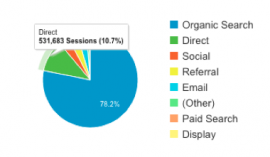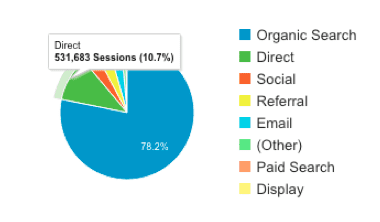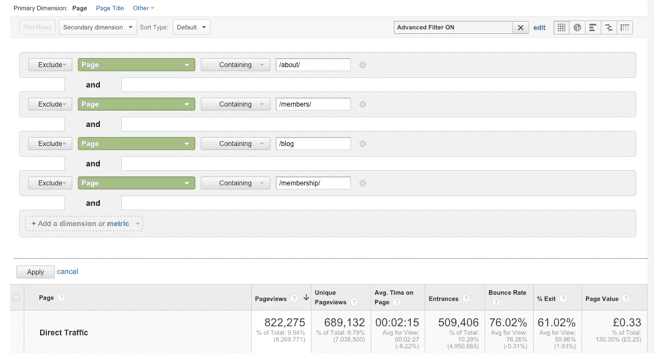Measuring the importance of Dark Social visits


Dark Social can be a sinister force that wrecks your budgeting models, unless you account for it
You may or may not have heard of ‘dark social’, but I can guarantee if you use social media, you will have created ‘dark social’ visits. That is, if you have ever seen an interesting news story and grabbed the link and sent it to a friend on Facebook Messenger, or texted your mum asking if she still wants those tickets to see Mumford & Sons for her birthday and included a link to the venue’s website.
Although social shares direct from social networks can be easily tracked, a huge amount of social sharing occurs off radar. This can be when people forward emails to colleagues or copy and paste links to send to one another via text, Facebook Messenger or any other messaging platform. Tracking can also be limited if there is a clickthrough on a link someone is checking out on a moble social media app. These shares are not tracked since they are not a link from one site to another and when someone arrives at the site from one of these platforms they do not have a ‘referrer’. This means when they arrive at the site, Google Analytics, or whatever analytics software you use, won’t know where they came from. This means they appear as ‘Direct’ in your Google analytics and this can be a significant proportion, typically more than 10% of visits.
This is a legacy of how the web was originally built. If you click on a link on another site then that’s a referral. If it’s a referral from a social media site then that’s counted as social. Organic search its anyone coming via a search engine and reaching you through your rankings rather than based on a PPC listing. Direct logically should then be just the people typing the URL directly into the web browser. But it very much isn’t. As the graph above shows we get some 10% of our traffic from ‘direct’. But one in 10 people visiting an article on our blog aren’t laboriously typing out or following a bookmarked link like: https://www.smartinsights.com/search-engine-optimisation-seo/seo-strategy/google-algorithm-update-core-ranking-algorithm-changes-smartinsights-alert/ (kudos for anyone who actually has by the way) just to find some news on the latest Google algorithm change.
What is actually happening is that people are going to that URL from platforms where they can’t be tracked from, and thus it is appearing as direct when in reality it is ‘dark social’.
Dark social is estimated to make up 69% of all social shares and, depending on the referral mix of a site, can be up to one quarter of all shares. The data we see backs this up rather firmly. We get triple the number of visitors from direct than we do from social according to our analytics, yet we know not many of our visitors are arriving by typing in the exact address (and we do add tracking paramaters to our email links, so that doesn’t account for).
So, we’re looking at dark social since this has big implications for working out the value of different marketing activities and assigning marketing budgets. Lets consider a simple example to see why.
Example:
I have an ecommerce site selling ‘Pet Rocks’. I get 60% of my traffic from organic search, 10% from paid search, 25% from ‘direct’ and 5% from social media. My site has a 1% conversion rate (I sell 1 pet rock per 100 visitors) and on each pet rock I sell I make a £10 profit. I get 10,000 views a month, so that means I make £600 per month from people coming from organic, and only £50 per month from those coming from social media.

If I currently spend £200 per month on outreach and £200 per month paying a freelance copywriter to write content for my sites blog, I can conclude that I’m making a tasty profit of £200 per month on my organic traffic (£600 revenue – £400 spending). However if I currently spend £100 per month on social media campaigns and only get £50 in revenue from social media then it looks like I’m wasting £50 per month on social media and it isn’t worth the money I’m spending on it. I’d better cut down by on my social media spending or wind it up entirely.
Although the available data seems to back this up, I would actually be wrong to make this conclusion. If I analyse the traffic that comes to me direct, I find only 5% of it is going to my home page and the vast majority goes to various product pages and blog articles which have long URLs that people can’t possibly be typing in direct (unless it happens they have them bookmarked). It turns out these people have been coming to the site via ‘dark social’, and so I’d be wrong to write off my social media efforts.
It turns out 4/5ths of the traffic that was being counted as ‘direct’ was actually ‘dark social’ and only 1/5th was people actually typing in the URL. This means if Dark Social is counted under the social section, social as a whole is making £250 in revenue from the 2,500 people it brings in, and thus my £100 social budget is more than justified. In fact, it might be worth trying out spending more to generate more buzz around buy pet rocks to generate further social traffic, both visible and dark.
How to measure your Dark Social via Google analytics
This method of estimating dark social is only an estimate, but it is a great way to simply get a handle on what percentage of your ‘direct’ traffic is actually coming from people who have had the URL shared with them via a friend rather than typing it in direct.
Go to your behaviour tab on your Google analytics, go to site content and select all pages. Create a segment so you are only looking at direct traffic and apply it. Then open up the advanced filter and set up a series of dimensions that exclude pages that contain very short subfolders (that’s the part of the URL after the domain, e.g. /blog).

With these pages excluded, what we have left for the URL structure on our site is pages with long sub-folders that people are highly unlikely to type out when entering your site (there are cooler, but much less straightforward ways to assess this through regular expressions, by the way). The total number of page views from these pages gives you and indication of the traffic you are getting from ‘dark social’. I should put out that of course sometimes people will be going to long URLs direct, especially when they are saved in their browser, so this method only gives an approximation of your dark social traffic than an actual concrete amount. You could refine this by excluding repeat visits via these URLs.
There are other ways to set up your Google Analytics to measure dark social, all have their upsides and downsides. This method detailed here is a little simplistic and can take a little while to set up, but we’ve used it to given an indication of how to account for the sinister sounding traffic driver.
From our sponsors: Measuring the importance of Dark Social visits



